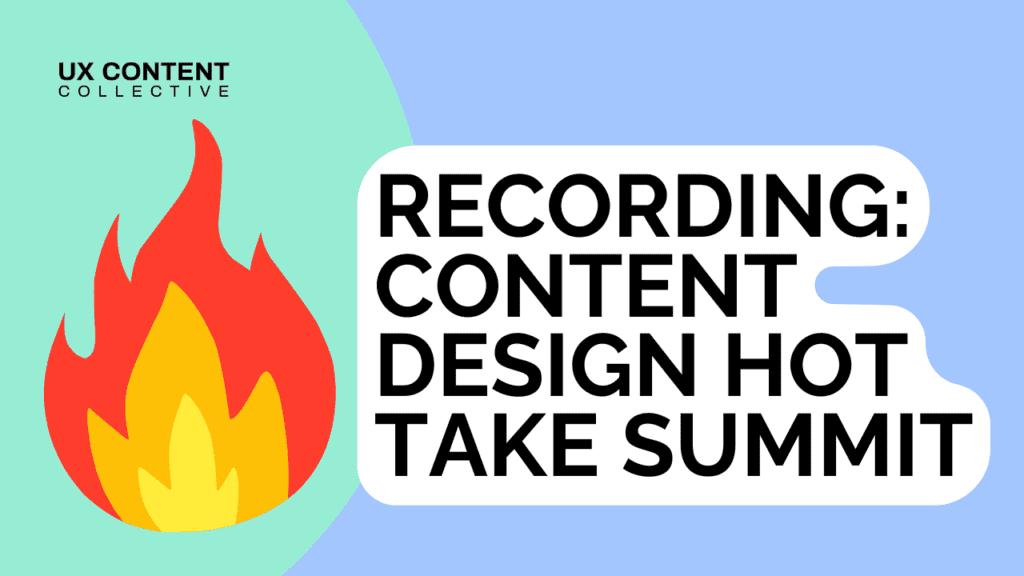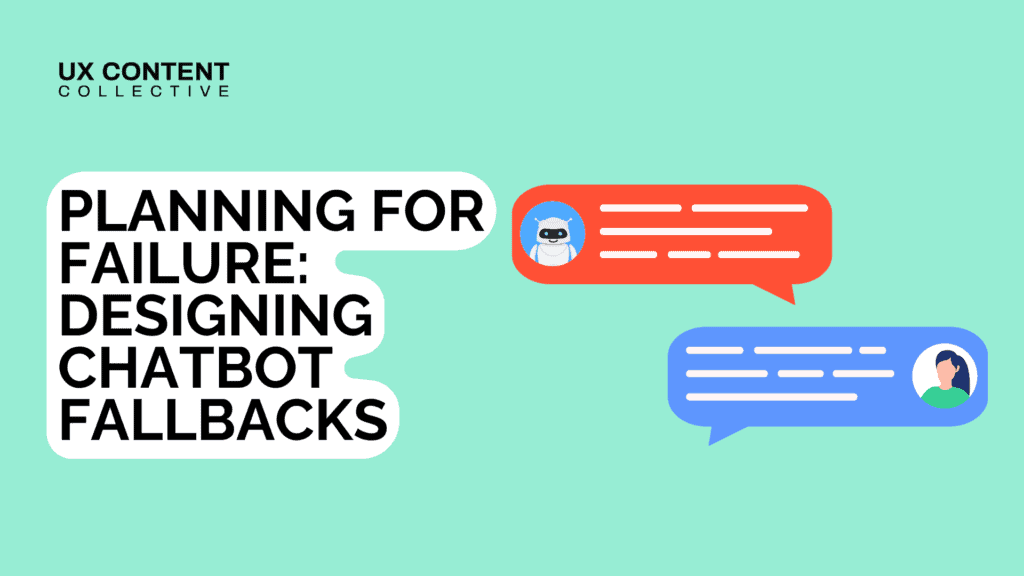
The content design hot take summit

Patrick Stafford

Interested in UX writing and content design?
Explore our content design and UX writing training:

Interested in content design? Check out our complete guide to content design (and how it’s different from UX writing).
In 2025 we hosted something new: the first-ever Content Design Spicy Take Summit. It was a fast-paced online event featuring 5 speakers, each presenting a single “spicy” opinion about the state of content design today. Some takes were controversial. Some were widely agreed with. But all of them challenged the status quo.
Each speaker had five minutes to present their hot take. Attendees asked questions after each talk, and at the end, we opened it up to a vote: which take was the most thought-provoking and well-defended?
Here’s what each speaker had to say.
Take 1: Frances Gordon – “Figma is killing content design”

Frances Gordon, the Principal Content Designer at Backbase, opened the summit with a bold claim: Figma, far from being a win for content designers, has quietly set the discipline back.
She argued that by framing “access to Figma” as a milestone, content designers ended up focusing on the wrong problem. We didn’t need better access to someone else’s tools, we needed investment in our own systems for managing, governing, and scaling content.
Her take was less about the tool itself, and more about misplaced effort. When content designers spend all day editing high-fidelity screens, she said, we’re not operating as strategic partners. We’re patching up problems we weren’t empowered to prevent.
“Let’s not confuse access to another discipline’s tool with actual empowerment within content design.”
Take 2: Brian Kelly – “Accessibility is a floor, not a ceiling”

Brian Kelly, a content design and strategy consultant, continued with a hot take on accessibility.
Brian focused on how content designers think about accessibility especially when designing for older users. His experience? Many teams equate accessibility with oversimplification: large text, minimal information, and stripped-down UI.
But that approach can actually backfire. Through both user research and personal experience (he lives in the world’s largest retirement community), Brian found that older adults want more control, more clarity, and more detail, not less. Many of them have been using technology for decades.
His argument: we need to stop thinking of accessibility as designing for people who are “broken,” and instead view it as a foundational baseline that benefits everyone.
“Clarity doesn’t equal simplicity. Accessibility raises the bar for everyone.”
Check out Bryan’s publication “Identifying Age Bias: A Framework for Age-Inclusive Content Design“.
Take 3: Audrey Ross – “Stop trying to make content-first design happen”

Audrey Ross, Senior Content Designer at Skylight, challenged a well-loved rallying cry in our field: content-first design. She argued that while the sentiment behind it is understandable, the framing is flawed and may even be holding us back.
Her take: saying content should come “first” reinforces a linear, siloed way of thinking. Instead, she suggested a different model: context-first design, where all disciplines contribute from the beginning, equipped with the information they need to make good decisions.
This approach emphasizes shared ownership and collaborative problem-solving, rather than advocating for any one discipline to take the lead.
“We’re not the sole holders of context. We’re one part of a fellowship.”
Take 4: Kate Agena – “Bring back ‘click’”

Kate Agena, VP of Content Design at SAP, questioned the long-held guidance that writers should avoid it in favor of more device-agnostic terms like select or choose.
Her team looked into this while building a component library and style guidance at SAP. After user research with people using screen readers and assistive tech, they found that many preferred the term click because it was clearer and more familiar, regardless of input method.
Kate wasn’t arguing to ignore accessibility concerns. Her point was that well-meaning guidance sometimes becomes dogma, and dogma needs to be reexamined.
“Click has transcended the mouse. It’s how people understand interaction.”
Connect with Kate on LinkedIn and check out what she’s up to with her Content Design Leaders membership community.
Take 5: Victor Beigelman – “Content design is holding itself back”

Victor Beigelman, Content Design Manager at Meta, aimed inwards. He suggested that many of the frustrations content designers express—being brought in too late, being undervalued, being mistaken for wordsmiths, are rooted in how we present ourselves.
He called out common patterns: fixating on grammar debates, hiding behind style guides, or responding with frustration when not looped in early. Instead, he encouraged content designers to show their work, build credibility through impact, and meet partners where they are.
His call was to shed the collective “inferiority complex” and step into new, fuzzier, more strategic spaces like LLM design, AI interfaces, and systems thinking.
“You don’t prove your worth by demanding inclusion. You do it by showing value.”
Check out Bryan’s publication on Substack where he discusses issues related to technology and culture.
The Winner: Audrey Ross
Attendees voted Audrey’s “Stop trying to make content-first design happen” as the strongest take. Not just for its provocativeness, but for the clarity of her argument and the thoughtful way she defended it.
Let’s have more spicy conversations
The Spicy Take Summit wasn’t just for fun (though it was fun). It created space for the kind of conversations we don’t always have in public. Like where our discpline might be falling short, what tools and frameworks are helping or hurting, and how we define value…and who gets to decide.
It also surfaced a quiet truth: content design is maturing, but not always in linear, predictable ways. If we want more influence, better systems, or stronger cross-functional partnerships, we’ll need to look past slogans and start having deeper conversations.
Stay tuned for the next event…



